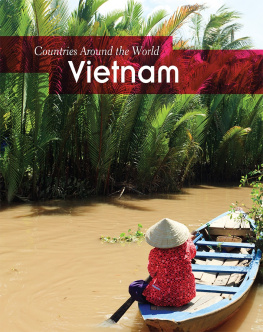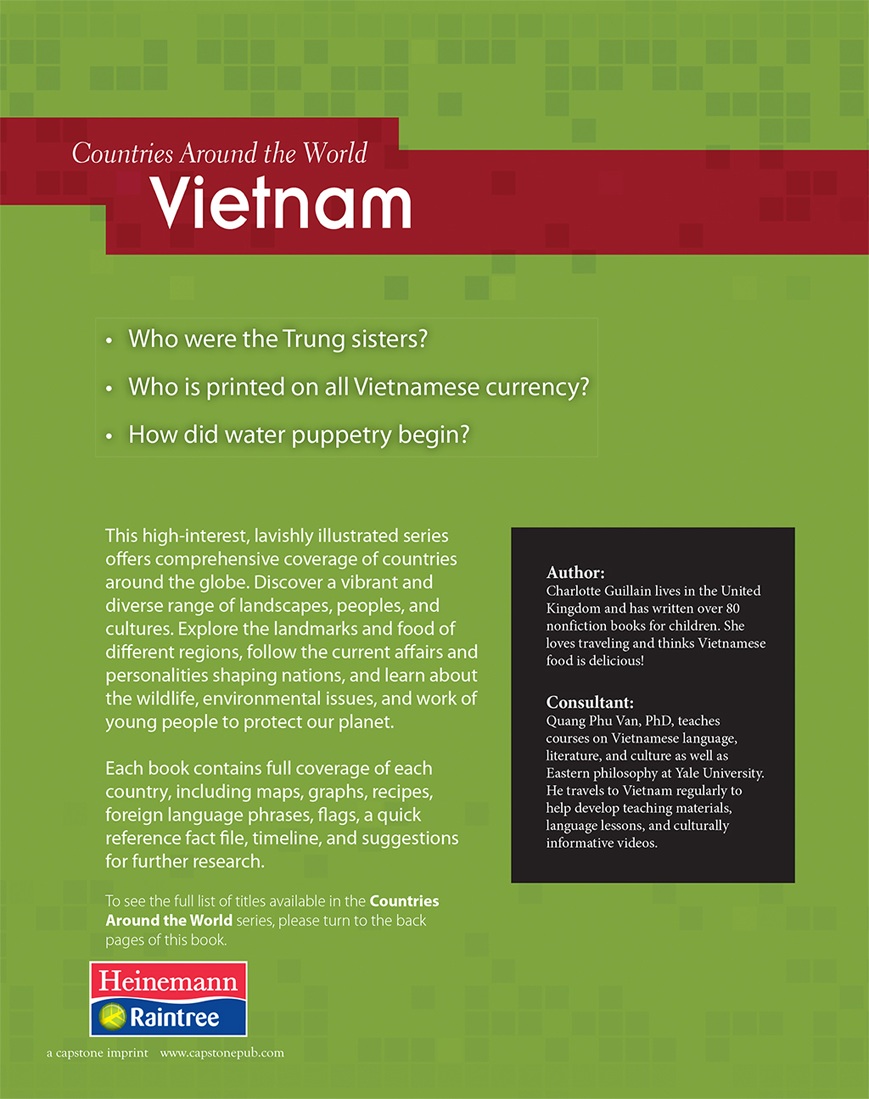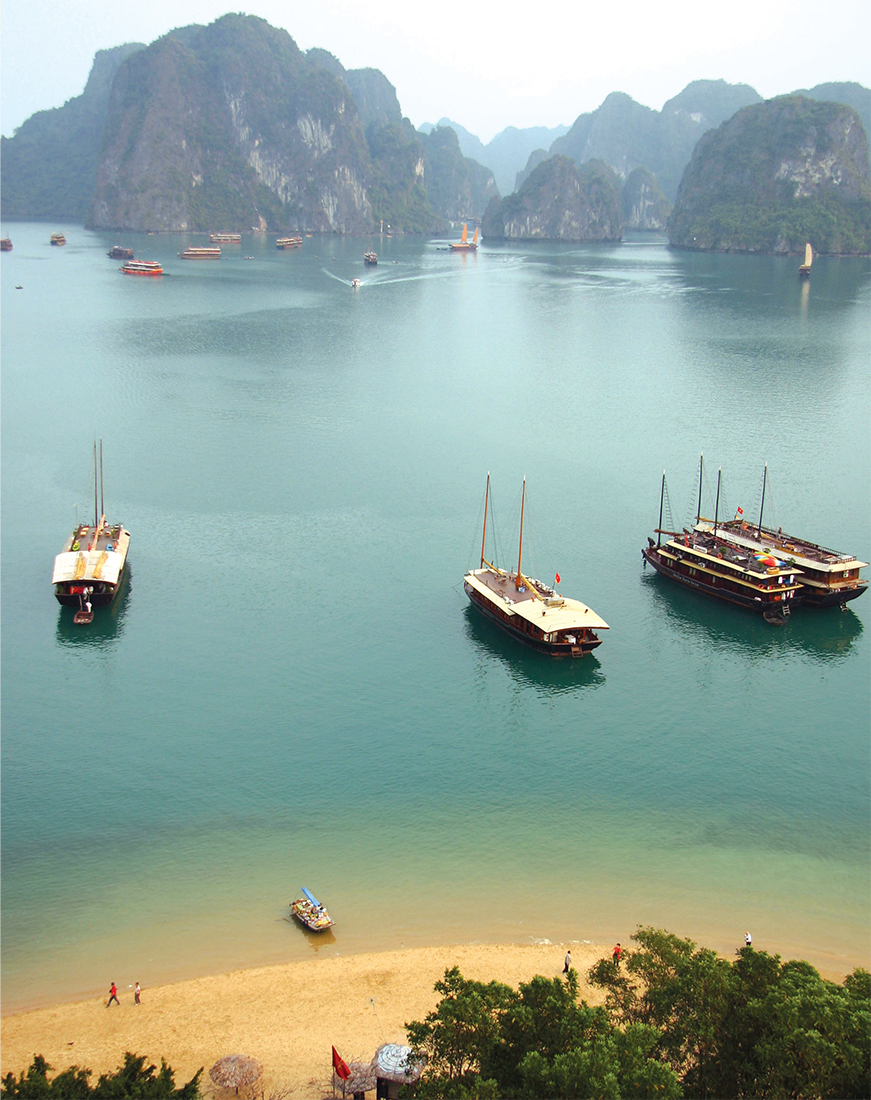Some words in the book are in bold, like this . You can find out what they mean by looking in the glossary.
Introducing Vietnam
What do you know about Vietnam? You may have only heard about the wars fought there.You may have eaten delicious Vietnamese food. But do you know where Vietnam is locatedin the world? What do you know about the countrys fascinating history and culture ?What does the landscape look like, and what are the main cities like?
Unique nation
Vietnam is a beautiful country that has recovered from the destruction of war tobecome an exciting nation. It lies in the eastern part of Southeast Asia. It coversan area of 127,880 square miles (331,210 square kilometers), a similar size to thestate of New Mexico. Hanoi and Ho Chi Minh City are lively, thriving urban areas.But much of Vietnam is countryside, filled with stunning forests, coastlines, mountains,and paddy fields . Some of the worlds rarest animals live in Vietnam.
Lands reunited
Vietnam has been invaded, turned into a colony , and divided over the centuries. Theeffects of this history can still be found today. But the Vietnamese people havemanaged to develop their own unique culture and customs. They are proud to show theircountry to visitors, who receive a warm welcome. Read on to find out more about thisfascinating country and its people.
How to say...
Here are some useful Vietnamese greetings:
Hello | Xin cho | (sin chow) |
| Goodbye | Tmbit | (tam bee-et) |
| How are you? | C khe khng? | (kaw kair kong) |
| Please | Lm on | (lam ern) |
| Thankyou | Cm on | (cam ern) |
Halong Bay is famous for its stunning natural beauty.
History: Conflict and Communism
For thousands of years, humans have lived in the lands that now make up Vietnam.Groups of people in the northern Red River Delta area grew rice around 4,000 yearsago. This led to a system of irrigation and an ordered society, called the kingdomof Van Lang. Its people, the Lac Viet, made bronze tools and had their own unique culture .
Chinese expansion and Indian influence
By 111 BCE Chinese emperors of the Han Dynasty (206 BCE220 CE ) ruled the Red RiverDelta region. China controlled the area for 1,000 years. As a result, Vietnamesesociety and culture became heavily influenced by China.
Today tourists visit the ruined temples from the Kingdom of Champa.
THE TRUNG SISTERS (UNKNOWN43 CE)
Sisters Trung Trac and Trung Nhi led a rebellion in 39 CE against the Chinese, andthey became the first rulers of Vietnam. Their reign as queens was short-lived, however,as better-organized Chinese troops beat them in 43 CE. Rather than face defeat, thesisters drowned themselves.
Meanwhile, southern regions were influenced by traders and settlers from India. Thecity-state of Funan was set up in the Mekong Delta, and it became an important centerfor trade between India and China until the 400s CE. Later, the Champa Kingdom becamepowerful in what is now central Vietnam.
Independence
The people in the north fought against Chinese rule for hundreds of years. Finally,in 939 the rebel Ngo Quyen became ruler of an independent Nam Viet in this northernregion. Lands to the south also gradually became part of the country, which remainedindependent for almost 1,000 years.
This map shows where the Kingdom of Champa was in central Vietnam.
Revolution and unity
Vietnamese lands were unsettled by wars and instability for centuries. China wasan ever-present threat, but the Vietnamese always resisted. The territory that makesup todays Vietnam was divided among a number of different ruling families who foughtand took land from each other. Eventually, Nguyen Anh made himself emperor of a unitedVietnam in 1802.
Europeans arrive
Portuguese traders arrived in the early 1500s, setting up trading centers and ports.They used these places to take goods between Europe and China. In the mid-1800s,France sent a military force to Vietnam. France was trying to compete with GreatBritain, which was expanding its own empire . In 1858 French ships took the port ofDa Nang, and they eventually took control of the Mekong Delta. A forced treaty withthe Vietnamese was signed, allowing France to rule various territories. By 1862 Francehad established a colony in the south.
French rule
By 1883 all of Vietnam was made part of a French protectorate . French officials ranthe country, while Vietnamese people were given low-level jobs with little pay. Francetook all the useful resources and exported them. Life for most Vietnamese peoplebecame harder. So, a national resistance movement grew, opposing French rule.
Daily Life
More land was farmed under French rule, but very few Vietnamese people owned thisland. Many poor people became tenant farmers , and they were forced to give as muchas 60 percent of their rice crop to landlords. Very few Vietnamese children wentto school at all. Only the richest could go to school with French children.

Many buildings in Saigon, such as this cathedral, are a reminder of Vietnam's colonialpast.
Communist resistance
By the 1920s some Vietnamese groups resorted to violence. The French imprisoned andexecuted thousands of people. In 1930 a man named Ho Chi Minh set up the Vietnamese Communist Party. This later became the Viet Minh. In 1945 the Viet Minh led a successfuluprising. As a result, the communist Democratic Republic of Vietnam was founded innorthern Vietnam, led by Ho Chi Minh. Meanwhile, France kept control of southernVietnam.
HO CHI MINH (18901969)
Ho Chi Minh was born Nguyen Tat Thanh. He lived in the United States, the UnitedKingdom, and France as a young man. He then returned to Vietnam to fight for independence.Ho Chi Minh led North Vietnam until his death in 1969. His image is still found allover Vietnam, and the southern city of Saigon was renamed Ho Chi Minh City afterhim.
More and more U.S. troops arrived in Vietnam during the 1960s.
Antiwar protestors in the United States held huge rallies, such as this one in Boston.
























